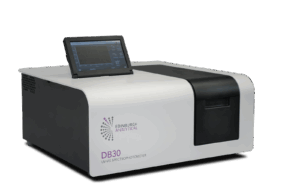Quantum dots (QDs) are semiconducting nanoparticles with unique optical and electrical properties, intermediate between bulk materials and discrete molecules. These unique properties are partly due to the atypically high surface-to-volume ratio of QDs, meaning a large proportion of their atoms are located on the surface of the crystalline lattice. Additionally, the radii of QDs typically range from 2 to 10 nm, which results in pronounced quantum confinement effects.
These effects cause the electronic bands in QDs to split into discrete energy levels, and this change in energy levels affects the material’s properties. As the size of a QD decreases, the band gap increases (Figure 1), which causes a change in the wavelength of the emitted light, electrical conductivity, and optical properties of the QD. This size-dependent tunability makes QDs useful in a wide range of applications such as photovoltaics, biomedical imaging and display technologies.
Figure 1: Band structure of a bulk semiconductor vs. QDs, and effects of QD size on band gap. Arrows represent the transition corresponding to the first excitonic absorption
In this Application Note, an Edinburgh Analytical DB30 UV-Vis Spectrophotometer (Figure 2) is used in the characterisation of CdSe/ZnS QD samples in solution. By using the direct relationship between the first excitonic absorption peak and particle size, the diameter of QDs can be determined as defined in ISO/TS 17466 (Use of UV-Vis absorption spectroscopy in the characterization of cadmium chalcogenide colloidal quantum dots, 2015).1 The touchscreen interface, fast scanning rate, and double-beam approach of the DB30 allow for simple and rapid analysis of QDs.
Figure 2: Edinburgh Analytical DB30 UV-Vis Spectrophotometer
Solutions of CdSe/ZnS QDs in toluene (Sigma Aldrich) were made to appropriate concentration (absorbance <1 at first excitonic absorption peak) and loaded into 10 mm pathlength quartz cuvettes. Toluene was used as the reference.
UV-Vis spectroscopic measurements were performed on an Edinburgh Analytical DB30 UV-Vis Spectrophotometer, using the touchscreen interface to set up parameters (Figure 3). A narrow wavelength range was chosen to better identify the first excitonic absorption peak.
Figure 3: Experimental parameters on DB30 UV-Vis Spectrophotometer touchscreen interface
The first excitonic absorption peak corresponds to the lowest energy optical transition between the discrete electronic states in the QD (Figure 1). Using DB30’s built-in Peaks and Troughs analysis, the peak for the prepared CdSe/ZnS solutions was found at λ = 526.0 nm (Figure 4). It was attributed to the excitonic transition from the ground state in the valence band to the first excitonic excited state in the conduction band.
Figure 4: UV-Vis absorption spectrum of CdSe QDs taken from the DB30 touchscreen interface. The Peaks and Troughs function determined the first excitonic absorption peak at 526.0 nm
The relationship between the diameter (D) of a QD and its first excitonic absorption peak is determined empirically by transmission electron microscopy (TEM) measurements, or X-ray diffraction (XRD) in the case of very small CdSe nanoclusters.2 In this case, the empirical sizing equation used was sourced from ISO/TS 17466, though some academic sources cite different coefficients dependent on possible errors within the TEM measurements.1, 3 The relationship formula according to ISO/TS 17466 is as follows:
It was determined that the diameter of the CdSe/ZnS QDs in the prepared solution was D = 2.64 nm. This demonstrated that UV-Vis absorption spectroscopy, carried out on the DB30 UV-Vis Spectrophotometer, provides a rapid method for estimating the diameter of QDs.
This Application Note demonstrated the use of the Edinburgh Analytical DB30 UV-Vis Spectrophotometer in a spectroscopic method for determining the diameter of CdSe/ZnS QDs. An easy method for the estimation of QD size is becoming increasingly important considering the growing number of applications of QDs in the biomedical and technological sectors. The DB30, with its user-friendly touchscreen interface and high scan speed, allows for fast and straightforward analysis and characterisation of QDs.

